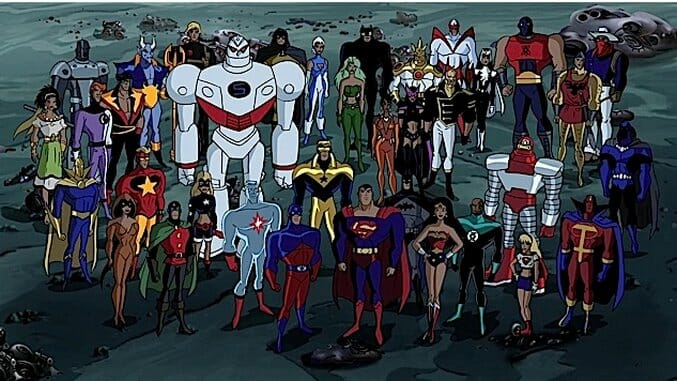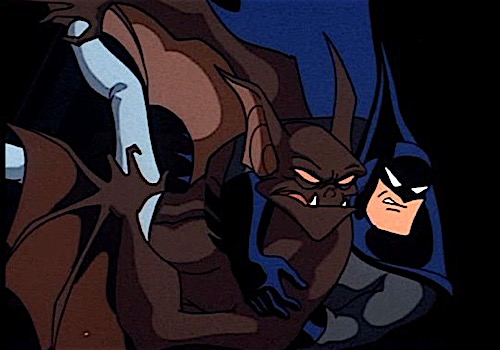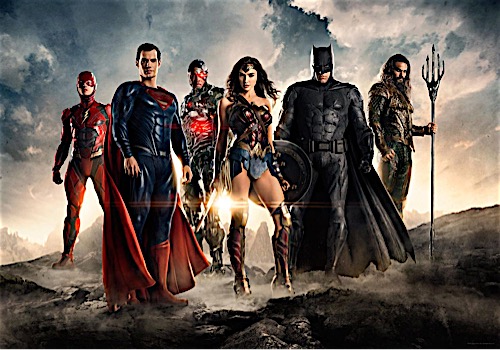All Hail the DC Animated Universe
Remember when Warner Bros. got it right the first time?
Movies Features DC
Cinematic universes, expanded universes, extended universes—every studio wants one. Marvel has of course kicked this gold rush into high gear, starting with 2008’s Iron Man. Since then, it’s ridden high, making roughly $10 billion in under eight years. Studios have had similar runs with franchises—Warner Bros. made a cool $8 billion or so with eight Harry Potter films in a decade—but even the juiciest franchise comes to an end, or at minimum goes dormant for a bit. The MCU? It can just keep cranking. Should a specific hero stumble, or should execs just decide to let a character lie fallow for a bit, there are plenty of other stories in the expanded universe left to explore.
So it’s no surprise that pretty much every studio is trying to build extended/expanded universes of their own. Warner Bros. is fitfully making a DC Extended Universe. Though Star Wars once had a rich, largely fan-driven expanded universe for decades, Disney has cleared the field and is set on releasing a new film year for the remainder of the decade as part of its own in-house cinematic universe. Universal is hoping to parlay its iconic movie monsters into an interconnected universe featuring Frankenstein’s monster, Dracula, the Wolfman, and others. Even toymaker Hasbro is trying to get into the game by developing a cinematic universe based on beloved toy lines such as G. I. Joe, Micronauts, ROM, and others.
When something works, imitators and emulators won’t be far behind.
As studio execs, directors, writers and the rest try to launch their own billion-dollar money-making machines, all will naturally be looking at Marvel for how to do it (or reacting against Marvel to establish a different path). But they’d do well to look further back, as well, to an expanded universe that did it first and, arguably, did it best—the DC Animated Universe. The DCAU combined eight animated series, four feature-length films, and over a dozen comic and video game series respectively into a harmonious ecosystem that birthed a living, breathing fictional reality from 1992 to 2006.
Of course, it’s difficult to miss the irony that the DCAU was built by the same studio (relying on the same characters!) that has been stumbling so badly in its attempts to match the MCU’s success. But instead of focusing on what’s being done wrong with the current effort, let’s instead take a moment to appreciate what the team behind the DCAU did right. And the DC Animated Universe—guided by producer and animator Bruce Timm, along with Paul Dini, Eric Radomski, Alan Burnett, Rich Fogel, Glen Murakami, James Tucker and Dwayne McDuffie—did plenty right. Ten years, after its end, the DCAU remains the most compelling argument for the importance of letting a universe expand organically, of taking risks, and, most importantly, of putting the right people in charge to oversee it all.
Lo, There Shall Come a Man-Bat

I’ll admit, it’s a bit unfair to compare the DCAU with the DCEU when it comes to organic beginnings. After all, when the first episode of Batman: The Animated Series debuted on September 5th, 1992, there was no grand plan or intention to craft a larger, expanded universe. Why would there be? The focus was solely on Batman and his world—and on making that world as cohesive and engaging as possible. The series pilot focused on a C-list villain, Man-Bat. Imagine any new series doing the equivalent today. (The villains in the first three episodes of the 2004 The Batman series? The Joker, Bane and Penguin.) Of course, there were plans to make this Batman universe serialized—we see glimpses of Harvey Dent before he becomes Two-Face, as well as other bits of Bat-lore slowly seeded throughout the first several episodes, but those bits of lore and the connections to the larger DC Universe are allowed to develop slowly.
The first sign of a non-Batman-centric, Justice League-associated character would not appear in the series until the introduction of the title character of episode 54, “Zatanna.” In it, we get a flashback to a young Bruce Wayne in training, learning the secrets of becoming an escape artist from stage magician (and DC Comics character) Zatarra. Young Bruce begins a flirtatious relationship with his mentor’s daughter, Zatanna, though it ultimately goes unfulfilled. Returning to the present, Batman and Zatanna embark on an adventure that opens the door to a larger universe where characters beyond the Batman mythos can appear. Instead of cramming Zatanna in to open this door, she appears as something integrated into the narrative and the character drama.
It would be another three years before the next non-Dark Knight DC character appeared, and, again, it would be one few casual viewers would recognize. In episode 78, “Showdown,” Batman’s arch-nemesis and near immortal Ra’s al Ghul recounts an experience during the days of the Old West, when his attempts to destroy the transcontinental railroad were thwarted by Jonah Hex, a bounty hunter with almost no connection to Batman.
Though “Zatanna” and “Showdown” were the first little pebbles, it was not until 1996’s Superman: The Animated Series that the DCAU started to coalesce. Batman and Superman don’t actually meet until October 4th, 1997’s superb three-part episode “World’s Finest.” That’s five years of stories before there was a fully realized DCAU. To say Timm, Dini, and company let anticipation build would be an understatement. They had also had plenty of time accustom viewers to the tone and feel of this newly expanded universe. Compare this to Batman V. Superman: Dawn of Justice’s “chock-full o’ characters, empty of character development” approach, and it’s easier to see why the latter feels so rushed and incomplete. It lacked history and gravitas.
The Material One’s Given
“Organic” should not be confused with “safe” or “cautious.” Though, admittedly, the overall stakes in the DCAU were millions if not billions of dollars lower than that of the DC’s current cinematic effort, that does not mean risks were not taken.

Consider the introduction of Terry McGinnis in the series Batman Beyond, along with an entire cast of new characters set in a neo-noir, Blade Runner-infused, future Gotham. Or Dwayne McDuffie and Denys Cowan’s Static Shock, an African-American superhero who got his own four-season series back in 2000. Or, the final animated series in the DCAU, Justice League Unlimited, which spotlighted not just B-level characters, but D-level forgotten heroes like Stars and S.T.R.I.P.E., Vigilante, Shining Knight, Fire and Ice, along with the Demon, not to mention the who’s-who of the Legion of Doom.
Sometimes what was in play was less risk than a willingness to reinvent, as in the Emmy Award-winning 1992 episode of Batman: The Animated Series, “Heart of Ice.” In it, Batman faces off against the, until then, utterly forgettable Mr. Freeze. Yet, Timm and Dini switch it up, turning Mr. Freeze from a forgettable goon with an ice motif into a tragic villain, desperately committing crimes to save his sick wife after an accident rendered him dependent on staying at cold temperatures. It feel less like a deviation from Mr. Freeze’s past than a long-overdue, fuller imagining of a undeveloped character. Even better, this expansion of character creates new and interesting stories.
In Whose Hands, the Multiverse?

Ultimately, the success of the DCAU can be attributed to those who served as both conservators and curators, as both interpreters and navigators. Timm, Dini, McDuffie and Burnett were especially attuned to what made this world tick. Burnett himself was deeply involved in animated depictions of superheroes, coming into the industry when Super Friends still aired. Timm was an experienced animator and storyboard artist with a passion for the old Max Fleischer cartoons of Superman from the ’40s, which gave the DCAU its distinctive visual style. Dini and McDuffie were both established writers and lovers of comics from the get-go, introducing new twists on established figures and presenting original creations (most notably in Dini’s case, Harley Quinn).
Equal parts stewardship (maintaining what’s vital) and mentorship (pushing to develop underused components), the role served by Timm, Dini and others seems conspicuously absent in a DCEU ostensibly helmed by Zack Snyder. There’s a failure to acknowledge the basic grammar of superhero storytelling, of understanding what one preserves and what one expands upon. (For evidence of this lack, look no further than the beginning of Batman V. Superman: Dawn of Justice where a photo journalist/CIA agent Jimmy Olsen gets a bullet to the face.)
Certainly there are plenty of differences between producing an animated series—or several of them, with a few films—and launching the multifranchise behemoth that the MCU has now set as a standard. Nonetheless, one would hope the success of the DCAU would give those involved in the DCEU some guiding principles by which to build. Given that both efforts stem from the same studio and rely on the same material—material that is pretty much the only true equal in resource to that which Marvel draws from—it should be inevitable. Still, until the current ship is righted (and spoilers, Suicide Squad will not help in that regard), there’s one iteration of DC in the multiverse to which we can turn.
We’ll always have the DCAU.